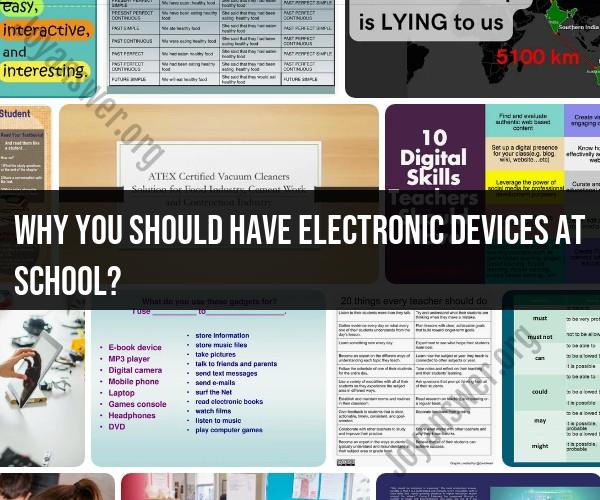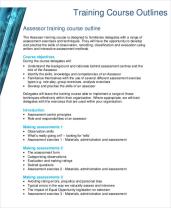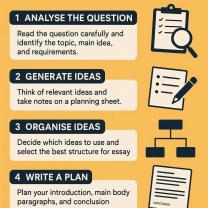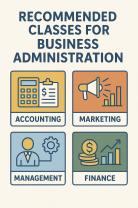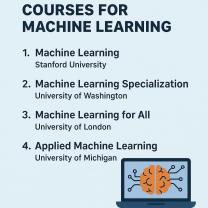Why you should have electronic devices at school?
Integrating electronic devices into the educational environment can offer various advantages and enhance the learning experience for students. Here are some reasons why having electronic devices in schools can be beneficial:
Access to Information: Electronic devices provide students with quick access to a vast amount of information. The internet, educational apps, and digital resources enable students to explore topics in depth, conduct research, and stay updated on current events.
Digital Textbooks and Resources: Electronic devices allow for the use of digital textbooks and educational resources. These materials are often interactive, multimedia-rich, and can be updated easily, providing a more dynamic learning experience compared to traditional printed materials.
Individualized Learning: Electronic devices enable personalized learning experiences. Educational software and apps can adapt to individual learning styles, allowing students to progress at their own pace and receive targeted support when needed.
Collaborative Learning: Electronic devices facilitate collaboration among students. Online platforms, shared documents, and collaborative tools promote teamwork, communication skills, and the ability to work on group projects effectively.
Skill Development: Using electronic devices helps students develop digital literacy and technology skills. These skills are increasingly important in the modern world and are transferable to various aspects of life and future careers.
Preparation for the Future: Integrating technology into education prepares students for the digital age they will encounter in their future careers. Familiarity with electronic devices and digital tools is crucial for success in many professions.
Engagement and Motivation: Educational apps, games, and interactive content can make learning more engaging and enjoyable for students. Electronic devices provide a platform for incorporating gamified elements into lessons, increasing motivation to learn.
Accessibility and Inclusivity: Electronic devices can be customized to accommodate different learning needs. Accessibility features, such as text-to-speech or speech-to-text functionalities, can support students with disabilities, fostering inclusivity in the learning environment.
Real-Time Feedback: Electronic devices allow for immediate feedback on assignments and assessments. This quick feedback loop helps students understand their strengths and areas for improvement, facilitating continuous learning and improvement.
Global Connectivity: Through the internet, electronic devices connect students to a global community. Virtual collaborations, online discussions, and interactions with students from different parts of the world provide diverse perspectives and cultural exchange opportunities.
Teacher Efficiency: Teachers can use electronic devices to streamline administrative tasks, such as grading, lesson planning, and communication with students and parents. This efficiency allows educators to focus more on teaching and providing individualized support.
While there are clear benefits, it's important to implement policies and guidelines to ensure responsible and purposeful use of electronic devices in schools. Balancing screen time, addressing cybersecurity concerns, and promoting digital citizenship are essential aspects of a successful integration of technology in education.
Electronic Devices in the Classroom: Powering Up Education
In today's tech-driven world, the debate surrounding electronic devices in schools continues. However, a growing body of research and successful implementation examples highlights the potential of these tools to significantly enhance the learning experience. Let's explore why embracing electronic devices in the classroom can lead to positive outcomes for students.
1. Reasons to Embrace Tech:
Boosting Engagement and Motivation: Interactive digital tools like educational apps, simulations, and virtual reality experiences can transform passive learning into active exploration and discovery. Imagine students manipulating 3D models of molecules in chemistry class or creating multimedia presentations for history projects. (Image of students using VR headsets in science class)
Personalizing the Learning Journey: Technology allows for personalized learning pathways, catering to individual student needs and learning styles. Adaptive learning platforms can adjust difficulty levels and suggest relevant resources based on each student's progress. Imagine students with reading difficulties using audiobooks and text-to-speech tools, while visual learners benefit from simulations and animations. (Image of student using an adaptive learning app)
Unlocking a World of Information: The internet opens doors to a vast library of knowledge, allowing students to research any topic in-depth, access multimedia resources, and explore diverse perspectives beyond textbooks. Imagine students using Google Earth to virtually tour historical sites or delve into interactive simulations of scientific phenomena. (Image of student researching a topic on a laptop)
Nurturing Essential Skills: Using electronic devices in the classroom fosters critical thinking, problem-solving, collaboration, and communication skills. Imagine students working together on online projects, analyzing data in spreadsheets, or creating presentations to showcase their learning. (Image of students working collaboratively on a computer project)
Preparing for the Future: Technology proficiency is no longer optional; it's essential for success in the 21st century workforce. Integrating technology into the curriculum equips students with the digital literacy skills they need to thrive in a tech-driven world. (Image of students coding on laptops)
2. Personalized Learning and Engagement:
Interactive Tools: Imagine students manipulating virtual models of historical monuments in history class or conducting virtual experiments in chemistry through simulations. These interactive experiences solidify understanding and boost engagement.
Differentiated Instruction: Teachers can utilize adaptive learning platforms to cater to diverse learning styles and levels. Students receive personalized feedback and resources based on their needs, ensuring everyone progresses at their own pace.
Creative Expression: Digital tools like presentation software, video editing tools, and online platforms provide avenues for students to express themselves creatively and share their ideas effectively. Imagine students creating animations to explain scientific concepts or collaborating on multimedia presentations for history projects.
Global Connection and Collaboration: Online platforms and video conferencing tools connect students with their peers around the world, fostering cultural exchange, collaborative projects, and diverse perspectives. Imagine students participating in online debates with students from different countries or collaborating on environmental projects with international teams.
3. Case Studies of Success:
Khan Academy: This online platform offers free educational resources and personalized learning pathways, allowing students to learn at their own pace and master concepts effectively.
Flipped Classroom Model: In this model, students learn core concepts through online lectures or videos at home, while classroom time is used for interactive activities, discussions, and problem-solving, leading to deeper understanding and active participation.
One Laptop per Child (OLPC) Program: This initiative equips children in developing countries with laptops loaded with educational software, fostering independent learning, digital literacy, and access to information even in resource-limited settings.
Remember: Successful integration of electronic devices requires careful planning, teacher training, and clear guidelines for usage. It's not about replacing traditional methods but rather using technology as a tool to enhance learning and prepare students for the digital world.
By embracing the potential of technology in education, we can create engaging and effective learning environments that empower students to thrive in the 21st century.
Let's work together to unlock the power of technology for education!
